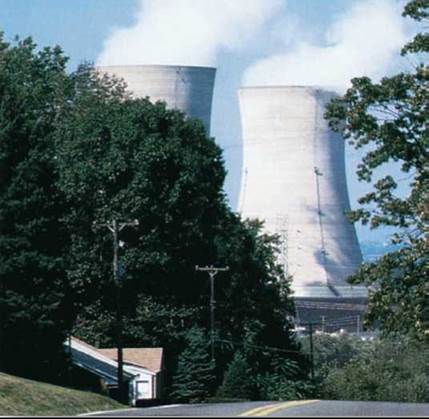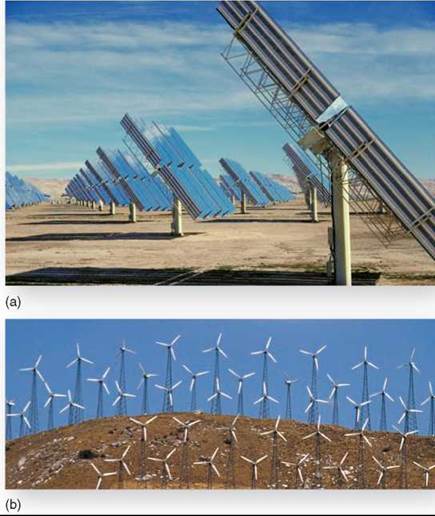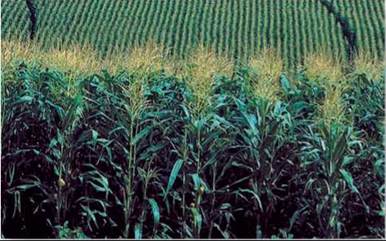THE LIVING WORLD
Unit Eight. The Living Environment
38. Human Influences on the Living World
38.10. Finding Cleaner Sources of Energy
Modem society’s propensity to burn fossil fuels has recycled an enormous amount of CO2 back into the earth’s atmosphere. To gain some idea, focus for a moment on your own personal contribution to the carbon cycle. Every mile you drive your car releases about a pound of CO2 into the air. How many miles do you drive in a year? You see the point? Think about the natural gas that heats your home, the electricity that lights it (mostly generated by the burning of fossil fuels). Your life is having a significant impact on the earth’s carbon balance. And you are not alone. Three hundred million other Americans are having a similar impact. In 2005 alone, the United States released 6 billion metric tons of carbon dioxide into earth’s atmosphere from the burning of fossil fuels (5,973,000,000,000,000 pounds!).
This massive flow of carbon dioxide into the atmosphere is having an unintended and very grave consequence—the earth is getting warmer. What can we do about it? Switch to alternative energy sources.
Many countries are turning to nuclear power for their growing energy needs. In 2007, 436 nuclear reactors were producing power worldwide, generating 14% of the world’s electricity. Seventy-eight percent of France’s electricity is now produced by nuclear power plants.
Nuclear power plants have not been as popular in this country as in the rest of the world because we have ample access to cheap coal and because the public fears the consequences of an accident. A reactor partial meltdown at the Three Mile Island nuclear plant in Pennsylvania in 1979 released little radiation into the environment but galvanized these fears. There has been little nuclear power development in this country since then (figure 38.19).

Figure 38.19. Three Mile Island nuclear power plant.
Since a nuclear accident here in 1979, the building of nuclear power stations in the United States has slowed dramatically.
In theory, nuclear power can provide plentiful, cheap energy, but the reality is less encouraging. Nuclear power presents several problems—safety, waste disposal, security— that must be overcome if it is to provide a significant portion of the energy that will fuel our future world.
Alternative Energy Sources
A variety of other sources of cleaner energy can help reduce our use of fossil fuels. Many of these are renewable energy—sources of energy, such as solar power, that are naturally replenished. The solar panels in figure 38.20a capture the energy of sunlight to heat water or other fluids to make steam that turns a turbine, generating electricity. Smaller applications use solar panels connected to photovoltaic cells, which convert solar energy directly into electricity. Other sources of renewable energy include wind (see figure 38.20b) and, in particular, biomass—plants like corn and sugar cane that can be used to produce ethanol, replacing gasoline in cars.

Figure 38.20. Alternate energy sources.
(a) Solar energy uses large mirrors to collect energy from the sun. These solar panels absorb heat from the sun that is used to boil water (or other fluids), which creates steam. The steam turns large turbines (not pictured), generating electricity. (b) Wind-powered energy is an old technology modernized for large-scale use. Large wind fields harness the kinetic energy in wind, converting it into electricity.
Looking More Closely at Ethanol
Ethanol is a simple two-carbon alcohol, CH3CH2OH—the same alcohol found in beer and wine. Rich in energy-storing C-H bonds, ethanol makes a good fuel. Burning a gallon of ethanol in your car releases about 80% as much car-powering energy as burning a gallon of gasoline.
How can we burn ethanol and not add more CO2 to the atmosphere? Focus on the word “more.” Ethanol is produced through yeast fermentation of sugars found in plants, the same fermentation process that is used to make beer and wine. If our automobiles burn carbon molecules recently produced via photosynthesis by living plants, then they are simply returning to the atmosphere the CO2 recently extracted from it! No net increase in atmospheric CO2 occurs.
To understand this, focus on where the carbon atoms come from. Burning a fossil fuel like gasoline releases into the atmosphere stores of carbon that had been trapped for thousands of years as oil buried deep in the earth. Burning ethanol also releases carbon, but in this case the carbon dioxide released into the atmosphere has just been taken from it. Think of the atmosphere as a fountain. A fountain recycles the water it shoots into the air. The level of water in the pool stays the same because the water added to the pool by the falling spray is recycled back to the pump to shoot up again. That is how ethanol works with regard to carbon dioxide emissions. Carbon dioxide is taken from the atmosphere and used by the plant to build plant tissue; that tissue is then used to make ethanol. Now imagine if there is a nearby tank of water (representing fossil fuels), and water from the tank was pumped and sprayed into the fountain’s pool. Not only would the tank get depleted, but the pool would overflow (too much carbon dioxide). That is what happens when fossil fuels are burned.
When used as fuel, ethanol is typically added to gasoline rather than burned by itself. New cars called Flexible Fuel Vehicles (FFVs) have a redesigned engine that can burn 100% gasoline, but can also burn a gasoline blend called E85 that is 85% ethanol and 15% gasoline. This adoption of ethanol for automobile fuel is good news for combating global warming.
In the United States, commercial ethanol fuel is traditionally produced by fermenting sugars obtained from starch stored in corn kernels. How might we get ethanol out of the rest of the corn plant?—of what sort of molecules are the stalk, leaves, and cob composed? They are made largely of three kinds of organic molecules: 40% cellulose, 40% hemi- cellulose, and 10% lignins.
Focus first on the cellulose. Fully one-half of all the organic carbon in the living world is cellulose. Like starch, cellulose consists of chains of glucose sugars linked together. Why not use the sugars in cellulose to make ethanol? Because there is a subtle but very important chemical difference between starch and cellulose. Each of the glucose sugars in a starch molecule has six carbon atoms arranged in a ring like a group of children holding hands in a circle. In a cellulose molecule, the rings of the glucose molecules are inside-out, as if the children are facing with their backs to the center of the circle. Yeast enzymes do not attack links between these kinds of sugars. To use cellulose to produce ethanol, bioengineers must find a way to teach yeasts to break these links.

There are microbes with enzymes that can do this, otherwise cows could not survive by eating grass, nor termites wood. Using the sort of genetic engineering technology discussed in chapter 13, it is possible to “bioengineer” a yeast to be able to ferment cellulose. Researchers in Spain have succeeded in commercially producing ethanol from cellulose biomass by adding DNA to yeast, DNA taken from plant-digesting bacteria in the gut of termites—DNA containing the genes these bacteria use to break down cellulose and free sugars.
Nor should we forget hemicellulose, which contains one-fifth of the corn plant’s carbon. Hemicellulose is like cellulose, but with five-carbon sugars. Genetically engineered bacteria containing the enzymes necessary to break down hemicellulose into free five-carbon sugars have already been constructed (The United States Patent Office Patent Number 5,000,000). So, this approach seems rich with promise.
Nor is corn the only plant that can be grown to produce biomass. There are other fast-growing plants that could be dedicated to fuel production, including switchgrass and trees such as hybrid poplar and willows. These plants can be grown on lands that are not suitable for row crops like corn, especially erosion-prone soils, leaving fertile soil for consumable crops such as corn, soybeans, and wheat. Other sources of cellulose from industrial and commercial waste, such as sawdust and paper pulp, could also be used to produce ethanol, and so could leaves and yard waste and the paper and cardboard that make up the bulk of municipal dumps.
It is difficult to imagine a more attractive long-term investment in our country’s future than developing strains of ethanol-producing yeasts that ferment cellulose and hemicellulose as well as starch. Our country should massively increase its funding of research in this area. With a serious national commitment to developing biomass-to-ethanol technology, we might all, in the not-too-distant future, be filling up our tanks with farm-grown fuels rather than fossil fuels, to the world’s great benefit.
Key Learning Outcome 38.10. Renewable energy alternatives, particularly auto fuels from biomass, are becoming increasingly important as cleaner energy sources.